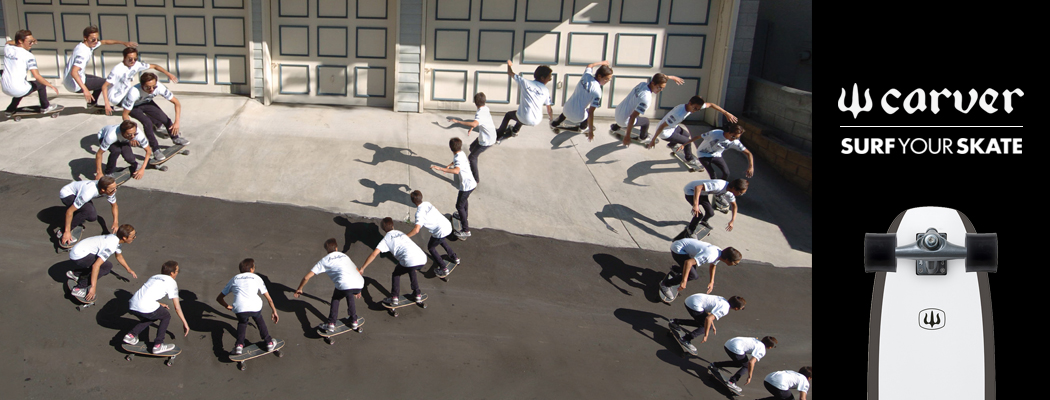

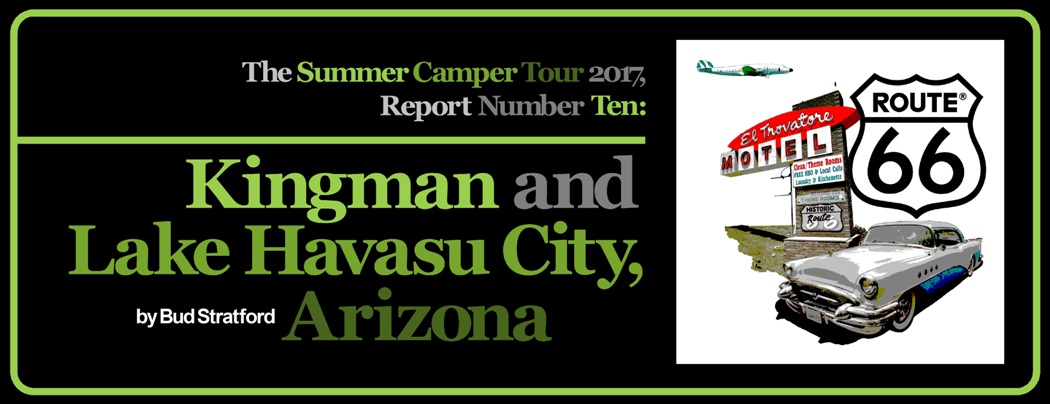
The Summer Camper Tour 2016/17, Report Number Ten:
Kingman and Lake Havasu City, Arizona
Saturday, May 13th through Sunday, May 14th, 2017
by Bud Stratford
Kingman and Lake Havasu City, Arizona
Saturday, May 13th through Sunday, May 14th, 2017
by Bud Stratford
My travels, generally speaking, are pretty solitary in nature. This weekend, however, was a rare exception. I met Mike Kitchen a couple months back at the SkaterCon event in Phoenix, where he was on hand to represent his sponsor, Millennium Skateboards. Being kindred skating souls in our mid-’40s that still live a very ’80s paradigm of skateboarding, we hit it off pretty famously right away. Ever since we met, Mike has made it a point to extend an assertively open invitation to me to come up to Lake Havasu City, skate a bit, and check out the local scene. Hearing that he would be leaving Arizona soon to spend his summer up in the Colorado Rockies, I cancelled my imminent plans to head off to Yuma and Southern California’s Imperial Valley, and fast-tracked my plans for a Northwest Arizona tour. An open invite, after all, is not something to be taken for granted or missed. Especially when it sounds like a heap-ton of fun.
Mike and his lovely lady, April, live on BLM land just north of Lake Havasu City. Their site is about two miles down a sandy wash, in the heart of a jagged mountain range, where they work as campground hosts while whittling away their time doing odd jobs to keep up a steady income. They live a very simple, yet extremely adventurous lifestyle, one that I was quite keen on seeing and experiencing for myself. This would surely be a prime boondocking opportunity, and I spent the week getting my micro-camper scrubbed down, geared up, and ready for the great unknown ahead of me. As always, Atlas Obscura and Roadside America offered a whole host of deliciously eccentric deviations for me and my wandering eyes to check out along the way, while Concrete Disciples shaped and shored up my skatepark search. While I was planning my round-robin trip, I decided to add the skateparks in Bagdad, Kingman, and Bullhead City to my overly-ambitious itinerary. If I’m gonna spend a weekend traveling all over the sparse northwest corner of the state, I might as well get everything I want to accomplish done in one efficient swoop. As you can see, my itinerary for this trip was stacked up pretty tightly. There was barely a moment left unscheduled and unaccounted for. From the moment that I left my house at daybreak (5am) on Saturday morning, I had a whole host of strange places to go, interesting things to see, and obscure oddities to document. In that regard, it was just like many of my more recent expeditions. At the same time, these journeys are always full of all sorts of surprises. You just never know what you’re going to stumble into along the way, no matter how obsessively-compulsively pre-planned your trip may be.
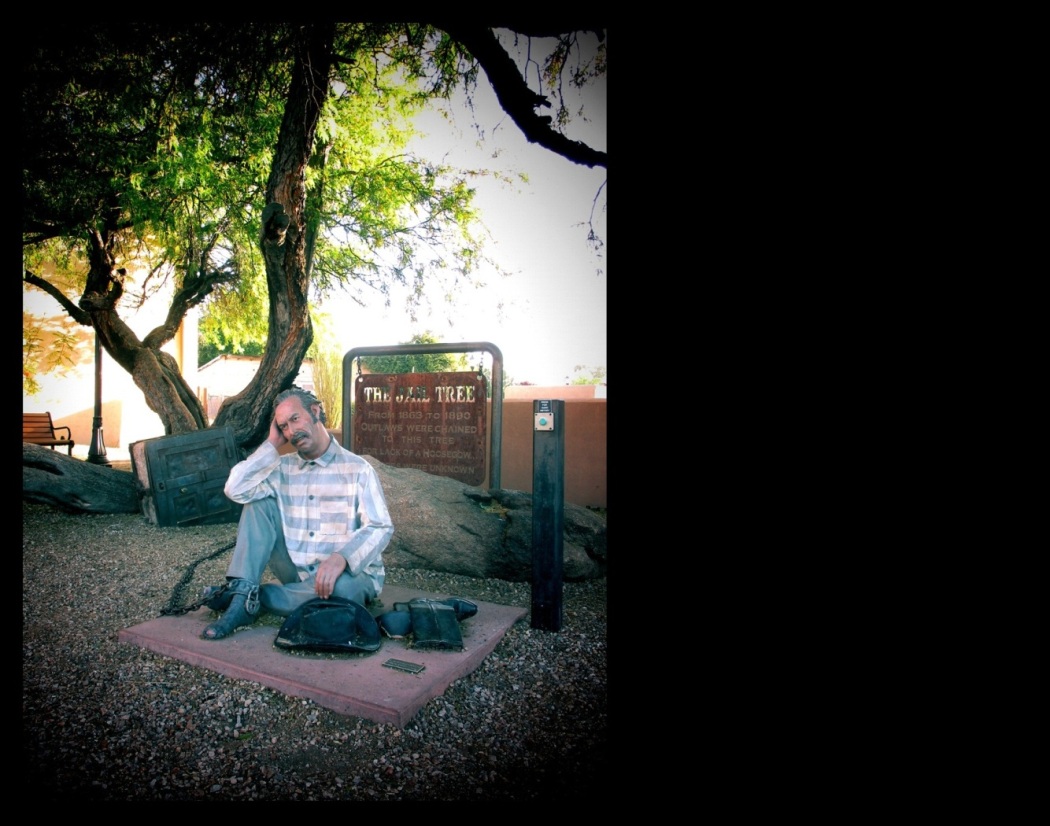
I’m staring bright-eyed at the prisoner sitting squat on the ground in front of me. The prisoner, on the other hand, is leaning heavily on his arm, staring back at me with dull, glassy eyes that suggest a long night of drunken hijinks might have precipitated his impromptu incarceration. He seems to be suffering from a hangover, coupled with a heaping helping of dismayed confusion. He’s not a real person, of course; he’s a mannequin dressed up in jail-stripe prison overclothes. But he’s a very convincing mannequin, and an unusually creepy one at that. Two feet away, there’s a steel pole with a bright green button that’s just begging to be pressed. I’m a skateboarder. I like to press buttons. So, I slowly and steadily reach across and give it a decisive poke. The mannequin startles me right out of my skin by suddenly speaking, his voice amplified by his fiberglass form. His easygoing drawl, however, is strangely disarming. The Jail Tree is far more urban legend and lore than it is an accurate historical recording. The story goes that, in the haste of Wickenburg’s sudden and spontaneous growth as a mining claim, they just didn’t have the time, the energy, or the resources to build a “proper” jail. Other priorities came first, and robbing the land of its various riches was definitely Priority Number One. Shackling arrestees to this mighty lump of a mesquite tree did the duty perfectly well for the town’s immediate purposes, the serendipitous by-product being a not-so-subtle, overtly public display of what would happen to certain segments of the populace if they decided to step anywhere out of line. Wickenburg is not widely known for harboring successful criminal contingents; the rule of law stands pretty solidly ’round these parts. After seeing The Jail Tree for myself, it’s pretty easy to see why that might be the case.

Giant Spurs sculpture, just north of Wickenburg, Arizona. Saturday, May 13th, 2017

Bagdad Skatepark, Saturday, May 13th, 2017.
The large mining interests of Freeport McMoran seem to own everything around here. They are, after all, the town’s largest employer and benefactor. It’s not a big town by any means, and it’s about twenty solid miles off the beaten path. The only way in and out is over a windy road traumatized by extremely hazardous twists, turns, hips, dips, and blind corners. The scenery is heavenly, but the drive is pure hell every single foot of the way. The skatepark looked great from Google Earth. They always do. It even looked great through the tall steel fence and the chained-and-padlocked gate. Across the way, I could see a playground standing idle, yet inviting. “There must be a way in there, somehow”, I thought to myself; and I was dead set and determined to find that way. A determined human is, after all, a fierce animal. A few doors down, somebody had left an entrance gate swinging wide open. My good fortune really does astound me sometimes. I ran back to the car as fast as I could, grabbed my board, and lunged straight for the skatepark. Oh, God. This place, wow. The transitions were… how do I put this nicely? “Definitely abrupt” might be fitting; “Absolute Torture” would be far more accurate. Things do not always skate as they seem, and this was Exhibit A of my unfortunate reality. There were two small nipples right in the way of my line that seemed to serve no functional purpose whatsoever, above and beyond making my life far worse than it already was. And then we had “The Quarterpipe Of Certain Death”, made far more lethal by the jagged razor-blade pebbles strewn around the base. I did manage to land a few grinds, and boy, did I ever feel accomplished for having done so. Bagdad is a company town, sure enough. And just like those lucky miners that manage to make it to retirement, I was happy as hell to make it out of there alive.
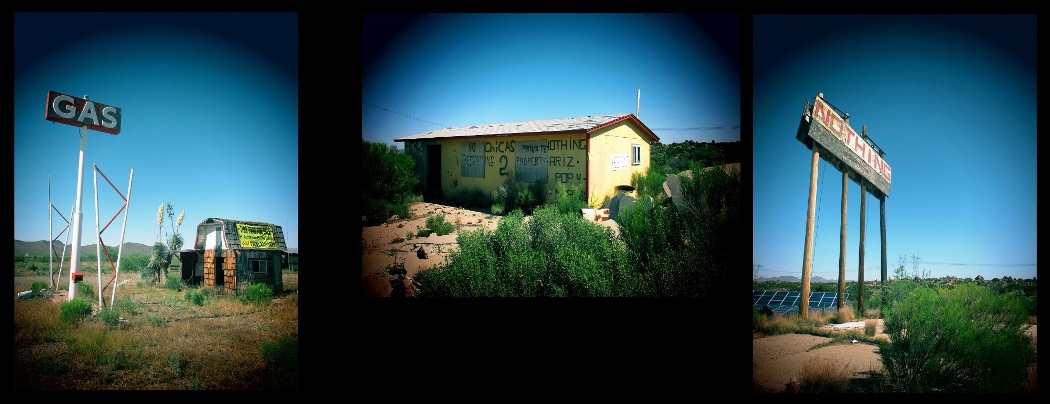
Left: Abandonment at US 93 and AZ 71, north of Wickenburg, Arizona.
Right two photos: Nothing, Arizona. “Population: 4, Chicas: 2”. Saturday, May 13th, 2017
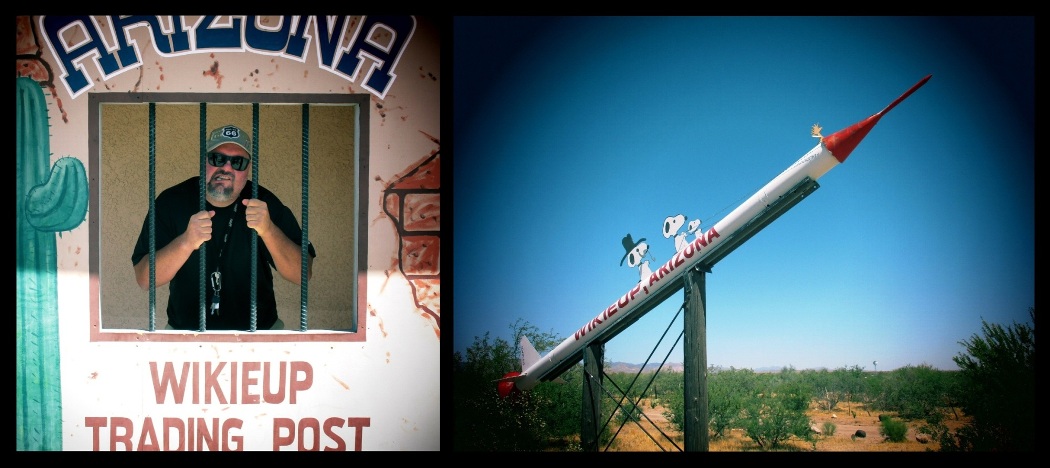
Left: At the Wikieup Trading Post Jail. Saturday, May 13th, 2017. Right: Snoopy on a Rocket, Wikieup, Arizona. Saturday, May 13th, 2017
Kingman, Arizona started life as a humble railroad siding named Beale’s Springs. This simple city subsequently grew and expanded due to two entirely unpredictable circumstances that could have never been imagined when it was founded in 1883: the certification and construction of Route 66, and the outbreak of World War II. Both brought a glut of infrastructure and humanity into to the area between the 1930’s and 1950’s; Kingman Army Airfield alone trained well over 35,000 aerial gunners during the wartime effort. Route 66 was how the government got them here, and Route 66 is how the Army Air Forces got them to the coasts, so they could ship straight to the front lines to do battle with Hitler and Hirohito. After the war, Kingman AAF became a Reconstruction Finance Corporation center, tasked with storing, selling, and ultimately scrapping entire air forces of obsolete Army Air Corps bombers; 5500 airplanes met their final fates at Kingman, most of them being ingloriously smelted down into raw aluminum ingots by fires that raged 24 hours a day. There used to be a small museum here dedicated to Kingman’s invaluable contributions to the war effort, but that museum is no more. A victim of public funding woes, a far-off-the-beaten-path location, and a general indifference towards such obscure historical tidbits (or even American History in general), the sole World War II remnant that survives at Kingman Airport is the original control tower, built in 1942 to handle Kingman’s burgeoning military air traffic.
The railroads and Route 66, however, are still the toasts of the town. There are historical spaces and places all over the city that have been lovingly preserved and restored to tell the tall tales, and there are several museums right in the heart of downtown to further educate and enlighten anybody that has an interest in the area’s past. It’s even possible to drive a long-forgotten and bypassed remnant of the original National Old Trails Route, the precursor to Route 66. Yes, it’s a narrow and harrowing drive along a sheer cliff that dead-ends at a former raceway, but it’s also a rare experience that illustrates just how unsophisticated (and unsafe) those old roads really were.
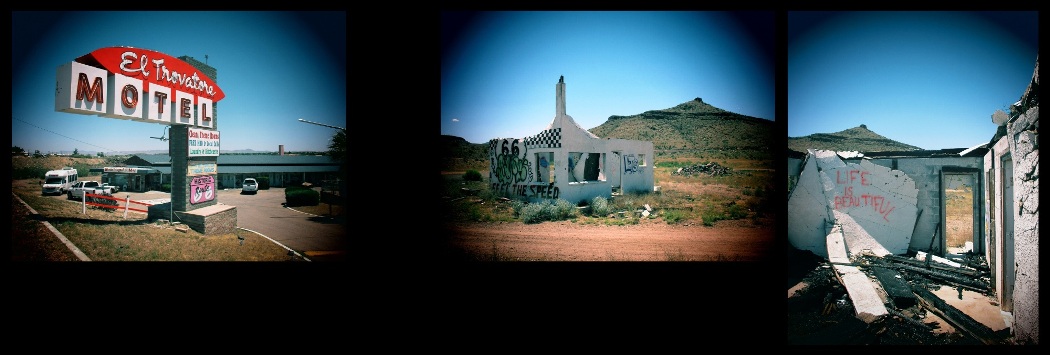
Left: The El Trovatore Motel’s restored neon, gloriously beckoning a new generation of Route 66 fans and aficionados. Saturday, May 13th, 2017
Right two photos: An abandoned raceway still (barely) stands at the end of the National Old Trails Highway, just southwest of Kingman, Arizona.
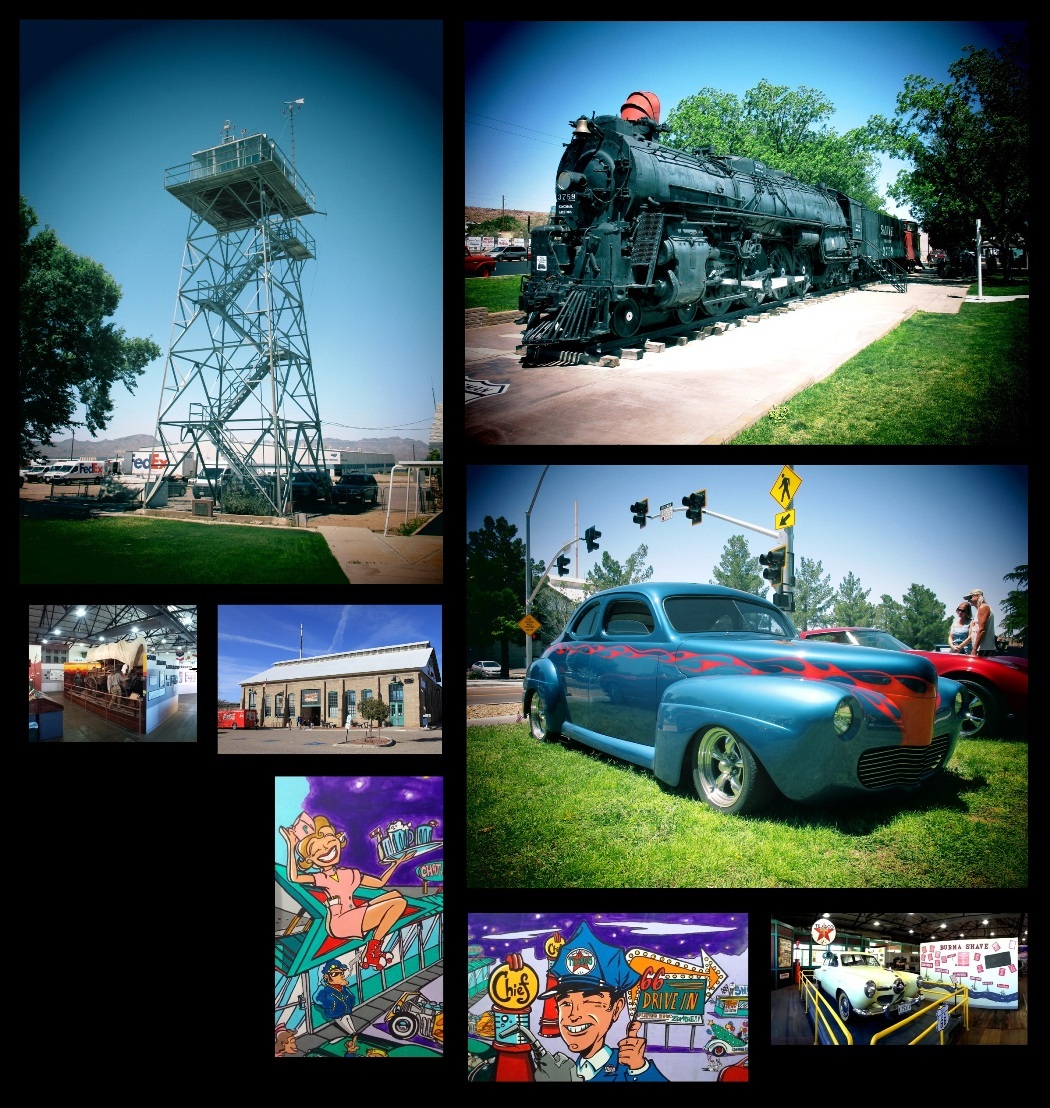
Clockwise from upper left: The original WWII control tower at the former Kingman Army Air Field (now Kingman Airport); steam locomotive and classic car show on Route 66 at Locomotive Park, Kingman, Arizona; the Powerhouse Visitors Center and Route 66 Museum, Kingman, Arizona (including displays, mural details, and the exterior facade).

The Kingman skatepark, however, left a hell of a lot to be desired. It looks as if it was designed fairly competently… you can clearly see some real potential here in the overall layout… but somebody, somewhere, seriously dropped the ball on the execution and the construction. It seems like it was poured and trowled by rank amateurs that knew little to nothing about the finer points of skatepark construction, let alone skateboarding. I’d be hard pressed to think of a bigger kink-sink anywhere in the world; I’ve certainly never skated anything quite this quirky in all my time as a touring skater.
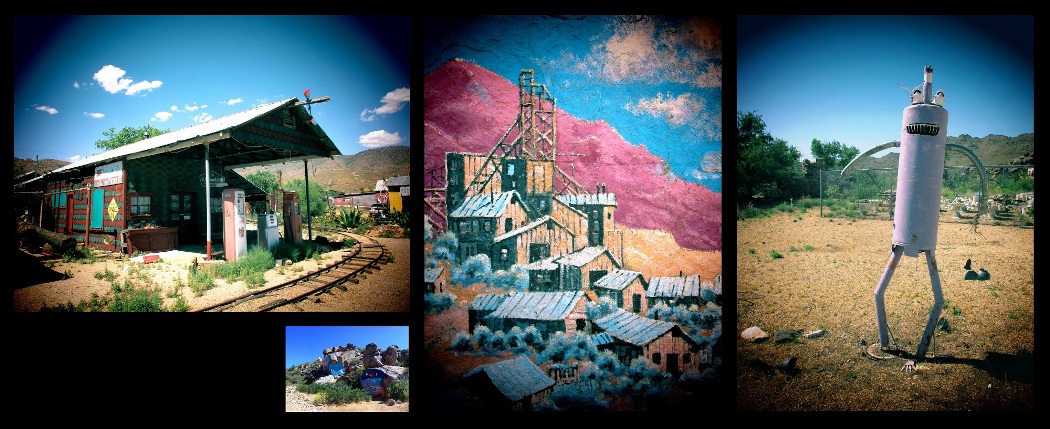
Clockwise, from upper left: The quirky art-enclave of Chloride, Arizona; mural detail; monstrous sculpture; the painted rocks that harbor the Chloride murals.
“In science, chloride is an ion used to desalinate seawater into drinking water. Which is ironic, because the Arizona town of the same name is incredibly dry. Founded in 1862 as a silver mining town, Chloride was once home to some 75 mines and 5,000 residents. The local miners excavated minerals like silver, gold, and turquoise for over six decades, until in the late 1920s when the town was burnt to the ground in its (near) entirety. By the 1940s, it had practically become a ghost town. Now Chloride is making a comeback, thanks to tourism. With new attractions like mock gunfights, Arizona’s oldest post office, and “The World’s Only All-Female Gun Fighting Troupe”, the town is a chance to walk through an original Wild West town. Yet amid all this, the two most unique characteristics of Chloride often go unnoticed. The bizarre junk art of Chloride can easily be seen along the roadside of the non-historic part of town. Drivers can admire a flamingo made of a gas tank, a tin man with a blue hat, and a junk tree with rusty items hanging from the branches. The graves in the town cemetery are even topped with old telephones. In fact, of the 20 currently-inhabited residences of Chloride, each of them features some display of junk art. One house, for example, features an elaborate bottle tree; another displays a metallic spider next to a caterpillar made of bowling balls. Harder to reach, yet equally worth the visit, are the Murals of Chloride. A 1.3-mile, 4-wheel-drive-only road past abandoned mines and ancient Native American petroglyphs will take you up the hill to the murals of Roy Purcell, who, in 1966, was a local prospector with some extra time on his hands. Not yet showing the signs of weathering, Purcell’s “The Journey” covers 2,000 square feet of cliffside granite and is dense in symbolism, featuring a yin yang, a giant red snake spanning multiple rocks, and a fertility goddess.”
– From Atlas Obscura

Left: “Poki, the World’s Largest desert Tortoise”. Bullhead City, Arizona. Right: The Lil’ Red Schoolhouse, erected in 1946 and currently residing at the Bullhead Community Park, Bullhead City, Arizona.
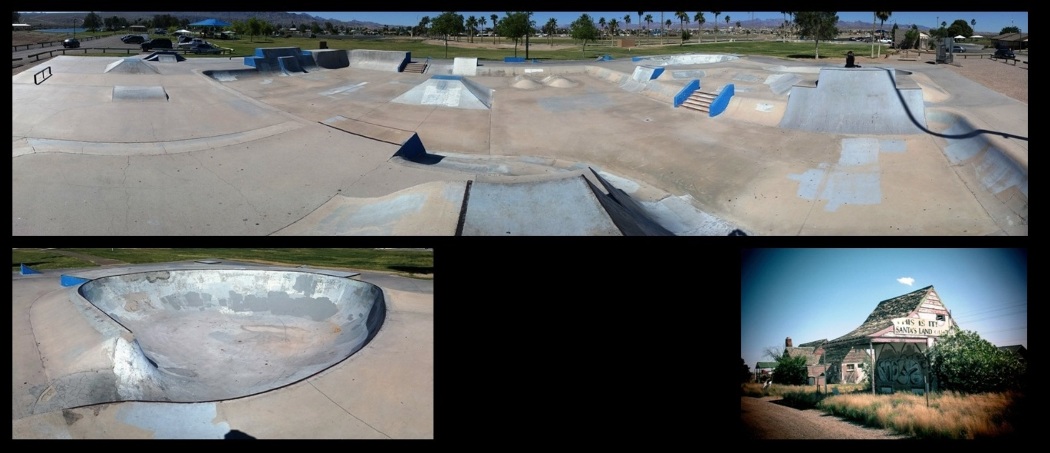
Lower right photo: Founded in 1937 by land speculator Nina Talbot and her husband, the unlikely roadside relic of Santa Claus, Arizona was the focal point of the couple’s strategy to entice forward-thinking investors to purchase lots out in the distant desert. Unfortunately, the tourist spot’s close proximity to absolutely nothing at all and the scalding summertime highs probably did more than anything else to insure its eventual demise. Even the relative success of the Duncan Hines- and Jane Russel-endorsed Santa Claus Inn could not stop the inevitable downward spiral; Santa Claus was sold in 1949, and was well on its way to ghost-town status by the early 1970s. The long-abandoned and nearly forgotten remnants of a land speculator’s dream investment, these empty shells still stubbornly stand twelve miles north of Kingman on the southbound side of US 93.
Oh, dear… Here, we have the third total blow of the day, the Bullhead City Skatepark. Another built-by-total-amateurs misconstruction masterpiece, this one featured flaking concrete that was peeling off the walls of the bowls in big chunks, and settling into the flatbottom, creating all sorts of unexpected hazards. You can see the rudimentary (but ineffective) attempt at patchwork in the photos. This might well be one of the worst skateparks that I’ve ever attempted to skate in my entire life.

Because of the lackluster quality (to put it mildly) of the Bagdad, Kingman, and Bullhead City skateparks, I managed to arrive in Lake Havasu City well before my scheduled 7 pm rendezvous with Mike and April. That allowed me to take a quick catnap before they arrived to escort me to their campsite far out on the northeastern edge of town. On the way to the site, we spotted several Mojave Green rattlesnakes crisscrossing the primitive road, and stopped to watch one of them rattle off a fair warning from beneath a bush (from the safety of our vehicles, of course). The evening was spent relaxing in outdoor easy chairs, reminiscing about skateboarding’s heydays, and the various misadventures that we’ve enjoyed all along the way.
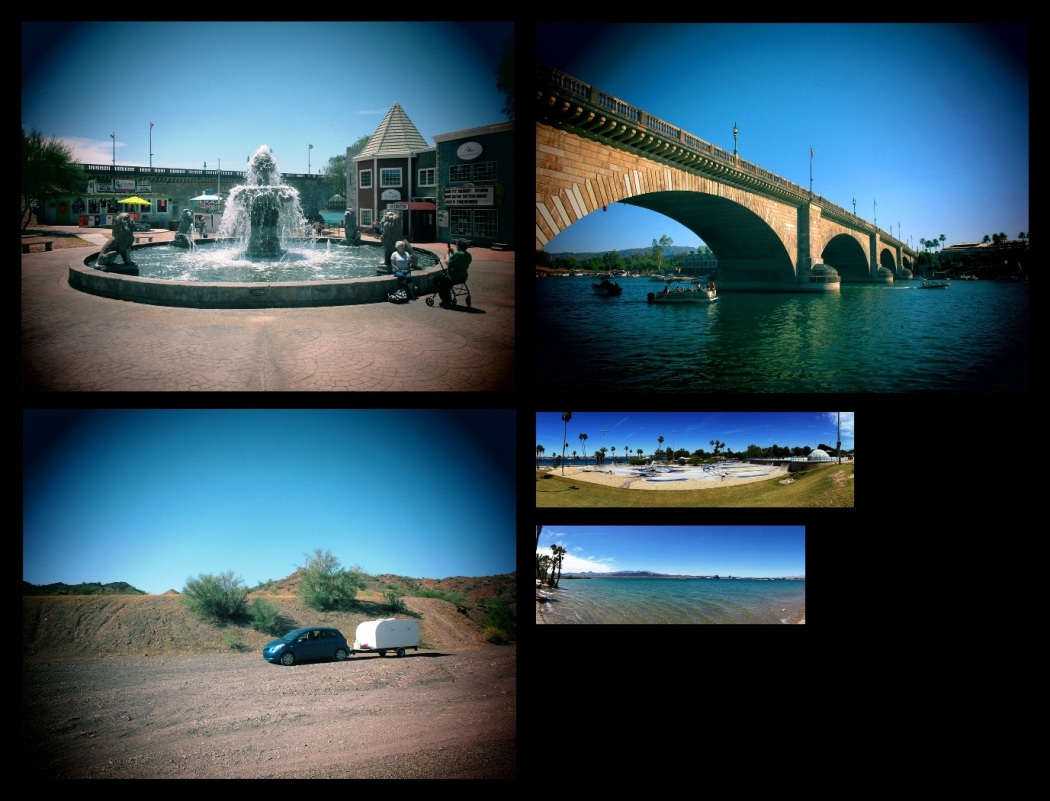
Clockwise from upper left: Fountain in front of London Bridge; London Bridge; the Lake Havasu City skatepark; the view from the river’s edge, looking toward California; the micro-camper way out in the boonies, Lake Havasu City, Arizona.
Sunday started at a local breakfast boutique named Rusty’s, where we tanked up on omelets, pancakes, Cokes, and coffee before making our way over to Beachcombers to fine-tune our boards a bit before we began the day’s skating adventures. Mike had a few seized bearings that he had to break free and lube, which gave me the time and the initiative to give my rolling stock a thorough clean-and-lube as well. Beachcombers was a surprisingly welcoming and well-stocked skate shop that shared its ample retail space with water skis, life jackets, kayaks, scooters, surf trunks, bikinis, and a whole host of miscellaneous “beachy” offerings. With our rides rolling smoothly, we made our way over to the first skate spot of the day.
Tillman Memorial Skatepark in Lake Havasu City is, as Mike put it so simply, “The sort of skatepark that’s built for pros to skate”. It’s massively huge and extremely impressive to be sure, but the one thing that it’s not is particularly “fun” for the average, ho-hum, run-of-the-mill, middle-aged skater. Everything in this park is super-sized to the max, so it’s definitely not the sort of place for easygoing guys like us to chill, relax, and enjoy the simpler pleasures of skateboarding. The view of the lake, however, was absolutely outstanding; we did spend some quality hanging time hanging at the beach before we made our way to the next spot on Mike’s to-skate list.

Because it’s shoehorned between a backdrop of high mountain ranges and the low-lying Colorado River Valley, Lake Havasu City is blessed with a bevy of drainage ditches that serve to re-route floodwaters harmlessly around and through the city during the infrequent (but potentially severe) monsoon rains that blow in throughout the fall. Exploring these ditches was the itinerary for the day, in lieu of killing ourselves at that monstrosity of a skatepark. The ditches were pretty manly, as it turns out, but at least we didn’t have to deal with any scooter kids at the ditches. That was a definite bonus.
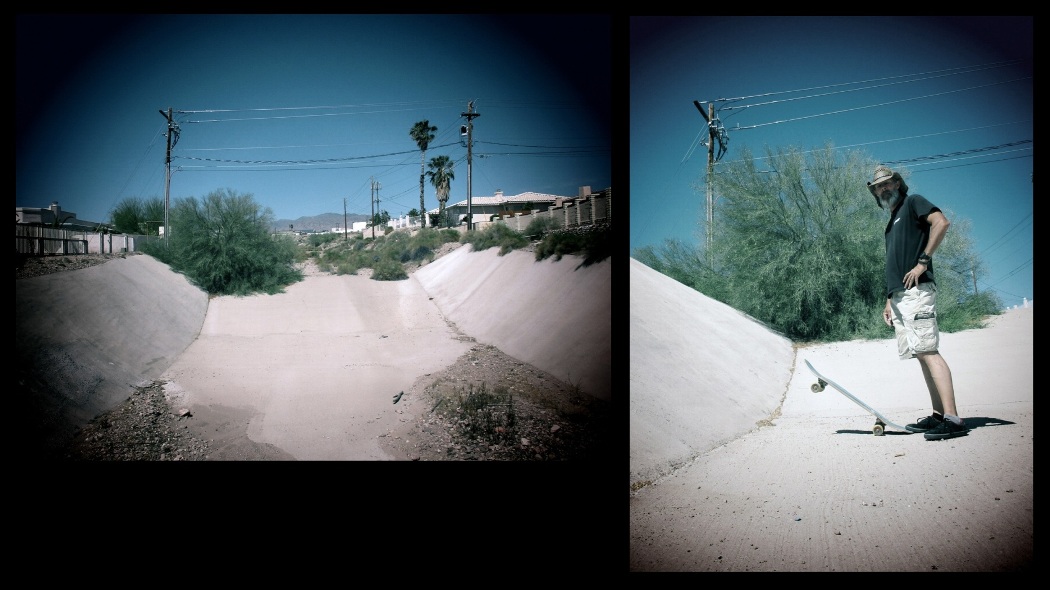
Right: Mike checks out the harsh transitions of our first ditch of the day. Left: The second find, just up the street from the first. Hot damn!
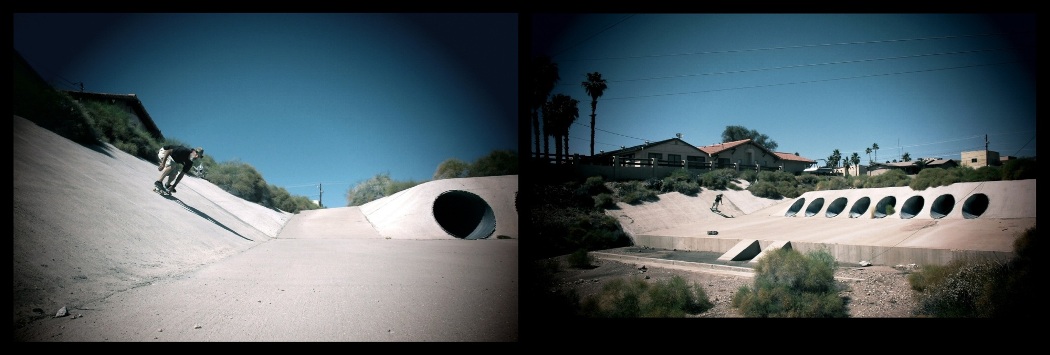
Left: Mike casually carves a speedy line while grabbing a rail to hold onto. Right: It was a real charm, complete with hips and roll-in channels.
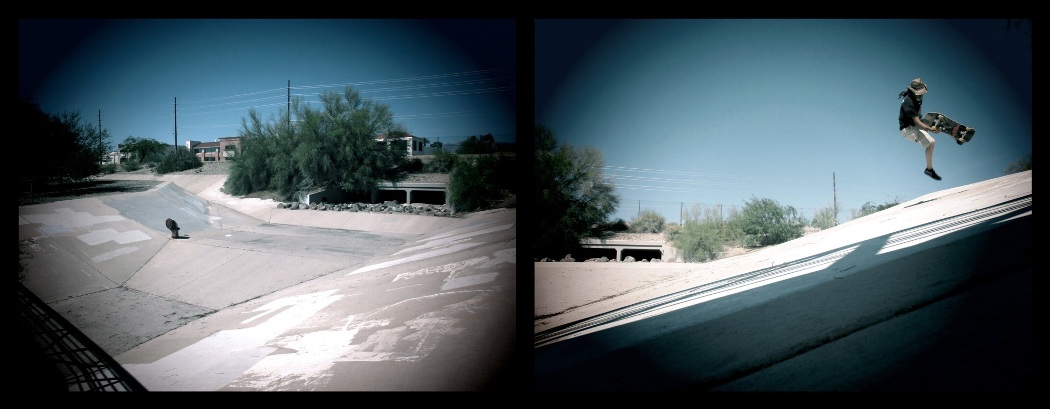
Right: Mike scoops up a beauty of a bean plant for the amateur photojournalist in me. Left: This mellow masterpiece might have been the best of them all.
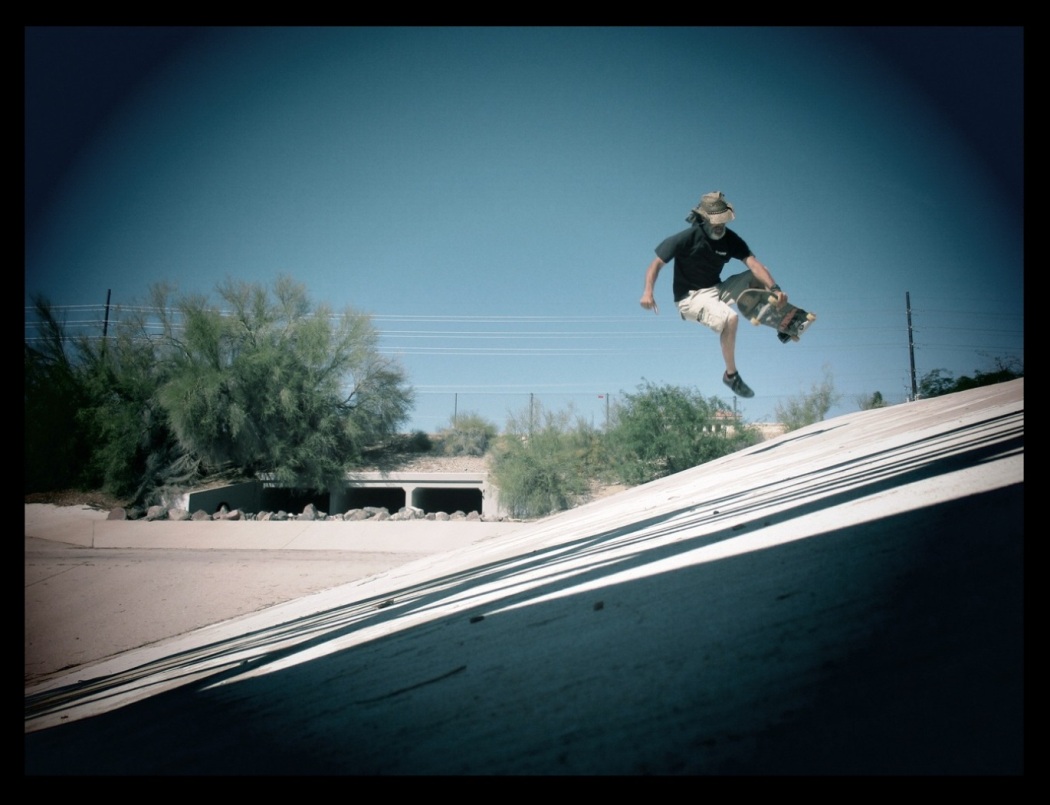
Mike doubles down with a Boneless into the back.
Mike and April really know how to win over a traveling skater. Food (and lots of it) pretty much wins every single time. That evening, before I hit the road for home, April made a Chicken Alfredo (from scratch) that completely knocked my shoes off. It smelled delicious just relaxing in their camper, which was sheer torture. Mike and I were seriously starvin’ after a long day of tossing ourselves around on harsh transitions and splatting our old bones onto the flatbottom; after a long afternoon of self-abuse, that Alfredo was a real smell and sight for sore eyes and empty stomachs. That dinner was the best dinner I’ve had on the road yet. If Mike and April ever invite you to dinner, don’t be stupid. Go…! I really didn’t want to leave, but I had a warm bed and an idle computer at home, patiently waiting for me to return. Even though the skateparks along the way ranged between mostly-to-entirely unskatable (for a variety of reasons), thanks to Mike and April’s hospitality and sense of adventure, the overall trip ended up being a real success story. When the going gets insurmountable, skaters start searching for alternatives. Thankfully, Lake Havasu’s geography has a lot of hidden gems, just waiting to be discovered. On my way out of town, I spotted another half-dozen (or so) ditches that we didn’t even see in our initial search-and-destroy mission. If you decide to take a road trip to check it all out for yourself, bring along a broom, a shovel, and a pair of bolt cutters; they’ll serve you well in your skate explorations.
Until next time, travel safe, travel well… and by all means, travel often.

Summer Camper Tour 2016/2017, Report Number Nine: Kingman and Lake Havasu City, Arizona
